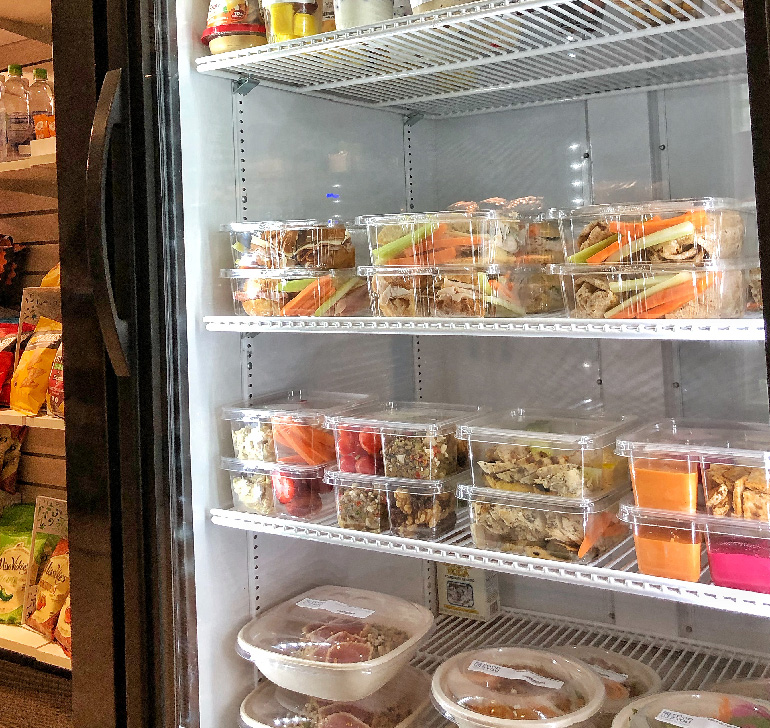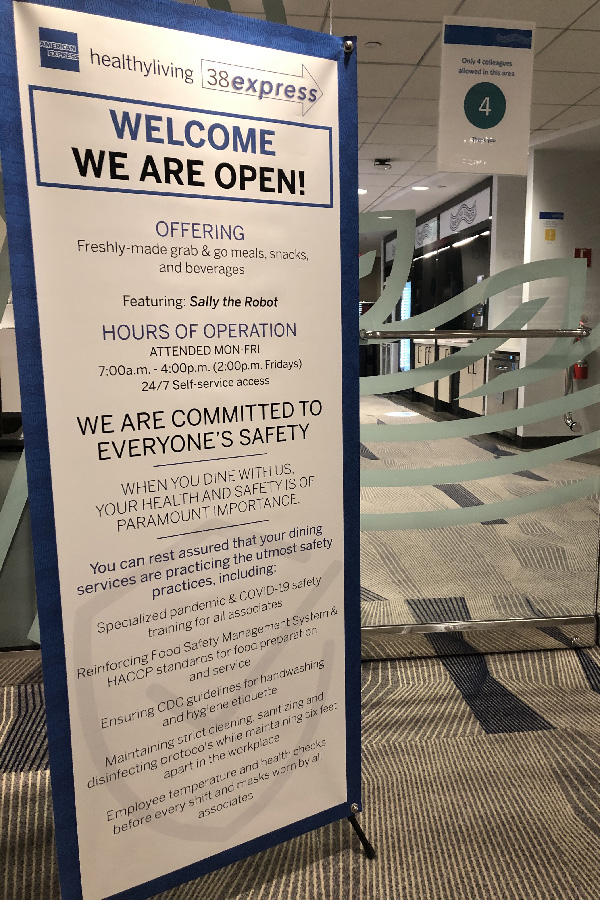In early September, American Express employees at the New York City office were able to return to work during the coronavirus pandemic. “Right now, there’s no incentive to return and our CEO has said those who can work from home should do so through June of next year,” says Jason Deville, director of hospitality and workplace services, Americas. Based on local transmission rates, the company is permitted to have up to 10% of its 7,000 New York City employees return to the office but so far, only about 1% have returned.
“We’re seeing about 70 employees come in,” says Deville, noting that the financial services company occupies about half the floors of a 54-floor building in lower Manhattan. “We’re still being very risk adverse. We don’t want people congregating in places in the building or really want people moving around the building at all.”
To give these employees a safe and convenient place for breakfast and lunch, the company has 38 Express, its micro market, open on one of the floors. “It’s the only dining service that we have available to those colleagues at the moment,” says Deville. Typically, the 7,000 employees can dine at the on-site cafeteria, complete with 15 food stations. As part of phase one reopening, they’ve increased the market’s assortment. “We’ve expanded the variety and focused more on upscale types of offerings,” he says. “It’s essentially sandwiches, salads, and hummus bowls—basically anything that can be pre-packaged for grab and go. We also offer hot breakfast items via a heated cabinet.”

Jason Deville, director of hospitality and workplace services, says AMEX likely won’t bring back its catering operations for meetings until 25% of employees come back to work.
Although staff maintains the operation, replenishing supplies and cleaning throughout the day, the micro market is unmanned. “There’s no cashier. Employees just pay via self-checkout,” Deville says. “There’s actually a salad-making robot that will produce custom salads on demand.” Sally the Robot, a sort of futuristic salad bar, provides customizable salads, bowls and snacks via a refrigerated and enclosed case. “It’s by a company called Chowbotics. You pick what ingredients you want in your salad, press the buttons on the screen, and it’ll build your salad there on the spot, and then dispenses it like a vending machine,” explains Deville.
Sally the Robot was installed before COVID-19 and any concern about social distancing as a way to offer customs salads in a location that is only sporadically used. As the company looks to reopen its offices with a new focus on social distancing, foodservice robots may become more widely used. “We’re looking at this as a more viable option in the future for sure,” says Deville. “We’re talking to a couple of other companies that do robotic pizza chefs. Chowbotics has a couple of other solutions like grain bowls as well as customized yogurt or parfait bowls. There’s also coffee-making robots. These are fully automatic coffee machines where the wand is actually steaming the milk if you want a latte, for example. I was not a true believer until I actually tasted the coffee, and it’s phenomenal.”
 Photo: Deville has consulted with his vendors to learn how other companies are approaching B&I foodservice. “We always want to strive for mutually beneficial relationships,” he says, “and to make sure that we’re being good partners.”
Photo: Deville has consulted with his vendors to learn how other companies are approaching B&I foodservice. “We always want to strive for mutually beneficial relationships,” he says, “and to make sure that we’re being good partners.”
When American Express moves to phase two reopening, Deville says portions of the company cafeteria will likely reopen, but the service model will be different. “Pre-COVID, we already had a dining app where colleagues could preorder and prepay for food,” he says. Going forward, there will also be kiosks in the cafeteria in place of cashiers. Employees will use the app or kiosks to order and pay for food and can choose to have it delivered to their floor or pick it up themselves from the cafeteria.
Moving from phase one to phase two depends on the local market’s positivity rate and decline of positivity rates over time. With that parameter met, a project management group and a steering committee will consider whether the next stage of reopening is appropriate. However, based on only 1% of the workforce returning so far, Deville says they may not move to phase two dining if there are not enough employees inside the building.
In the meantime, Deville and his team have had to pivot and significantly scale down operations. “Typically, we capture about 30% of our onsite employees via the cafeteria and almost half of our revenue came from catering meetings,” he says. As all of the grab-and-go items in the market are prepped in the cafeteria kitchen, he’s only brought back about 3% of his dining staff. “We’ve also had to work really closely with our vendors and renegotiate contracts,” he says. “A lot of this has been making the most educated decisions that we could make and doing the right thing with American Express’s resources to take care of our colleagues while also being financially responsible.”